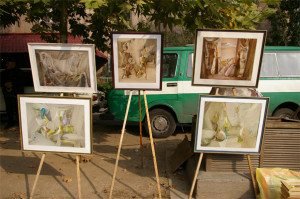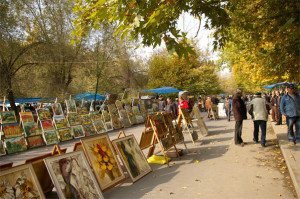YEREVAN—The vernissage is an open market that mainly caters to tourists, where they roam to purchase arts and crafts as souvenirs. It is on the location of a dilapidated park where a series of water fountains and wading pools once actively teemed. The concrete sidewalks are crumbling under foot, thus stumbling and tripping are to be expected.

The selection of goods has expanded far beyond oil paintings and hand-carved walnut backgammon boards to include random merchandise such as chemistry sets, puppies and dog leashes, decrepit Russian film cameras, mink fur caps, handmade silver jewelry, and stamp collections from the Soviet era. Essentially, if you need something—a handcrafted clay vase, vintage clothing, or even home goods—and are looking for a deal, the vernissage is the best place to start.
Yet the real purpose of the vernissage has always been to browse for paintings by local artists. The common vernissage spanning the block between Khanjian and Hanrabedutyan Streets, along with the original artists’ market located in Saryan Park adjacent to the Opera House, is where dozens of artists go every weekend, rain or shine, to display their latest works and anticipate at least one sale during the day.
The problem is finding the right kind of painting in a market cluttered with paint-by-number reproductions of white horses galloping through grassy fields and clowns gloomily waiting for children to amuse. You have to keep alert and expect to find a gem camouflaged by the mélange of stylized gargantuan mountains, reclining lions, and sail ships nearly capsizing in turbulent seas. A single stroll though the open-air mall is not enough.

Boris Ghazaryan has been setting up his easels in the same spot since he first started going to the vernissage in 1998. His works, which are mostly oil on paper or canvas, are among the most audacious and expressive on display. His charisma and comprehension of artistry is directly reflected in his paintings.
“About 10 years ago I couldn’t keep up with the demand,” he said. “I would frantically paint between 10 and 12 canvasses a week, then sell them all at the vernissage during the weekend. My wife would complain about my not being around, since I was upstairs in my studio painting day and night.” But it hasn’t always been so easy.
Exhibits featuring his works have been held in Berlin, Moscow, and Toronto, and he has fulfilled commissions for art dealers from Beirut, Switzerland, and the United States. Yet he is hardly known in his own city.
“Now months can go by without my having sold a single painting,” he said.
Born in a tiny village about 100 kilometers east of Akhalkalak, Georgia, Ghazaryan was educated in Yerevan, having graduated from the Yerevan State Pedagogical Institute in 1982.
For five years until the fall of the Soviet Union he was the chief artist of Zvartnots Airport, where he was in charge of installing and creating artwork. He also served as the arts editor of several Armenian newspapers during the Soviet era.
He participated in competitions and exhibitions all over the former Soviet Union. Many of his paintings were bought officially in Moscow and exhibited or sold elsewhere. For a work that was sold to the Spanish Embassy in the 1980’s he was paid a commission of 6,000 rubles, which was a considerably hefty sum for those times.
Akin to the masters of 20th-century painting, Ghazaryan changes his style every few years to keep his work fresh and alive. His techniques are copied, although not always successfully, by peers selling their own paintings not far from his post.
“But they have no idea what I’m doing,” he said.
His latest works are created using a special technique where the paints are applied using cotton cloths in a whirling, sweeping motions to suggest abstract, yet graceful poses of female figures and the village settings in which they are situated. For detailing, he twines a twisted swab of cotton around the tapered end of a fine paint brush.
A common theme of his work is the village life of women who are depicted carrying clay jugs on their shoulders, spinning yarn, or walking to church.
Other artists often try to discuss technique with him to probe his brain and provoke him to reveal something, but he does not oblige them.
“Some don’t have any vision, any foresight to understand, let alone try something daring. But I can’t blame them, they paint what they know.”
Ghazaryan never joined the Armenian painters’ union and didn’t ever have a desire, mainly due to lack of interest in the behind-the-scenes politics, for which he does not have the nerve.
“I can’t be bothered with all the politics, egos, and whatever else that has nothing to do with painting,” he said.
Just behind his spot, a no-name greasy-spoon cafeteria serves up fish stews, fried meatloaf patties known as “cutlets,” frankfurters, boiled or mashed potatoes, and red kidney bean salads, among other comfort foods the artists savor. The place is virtually invisible to tourists and frequented only by people in the neighborhood. As do many artisans, Ghazaryan goes there for a small bite to eat and a shot or two of vodka, but usually ends up drinking a few more than that by the end of the day. His favorite toast is always to joy.
“Without joy, you can’t do anything. No matter what you try to do or say, your work will never come out right. Life is simply all about happiness.”


Be the first to comment